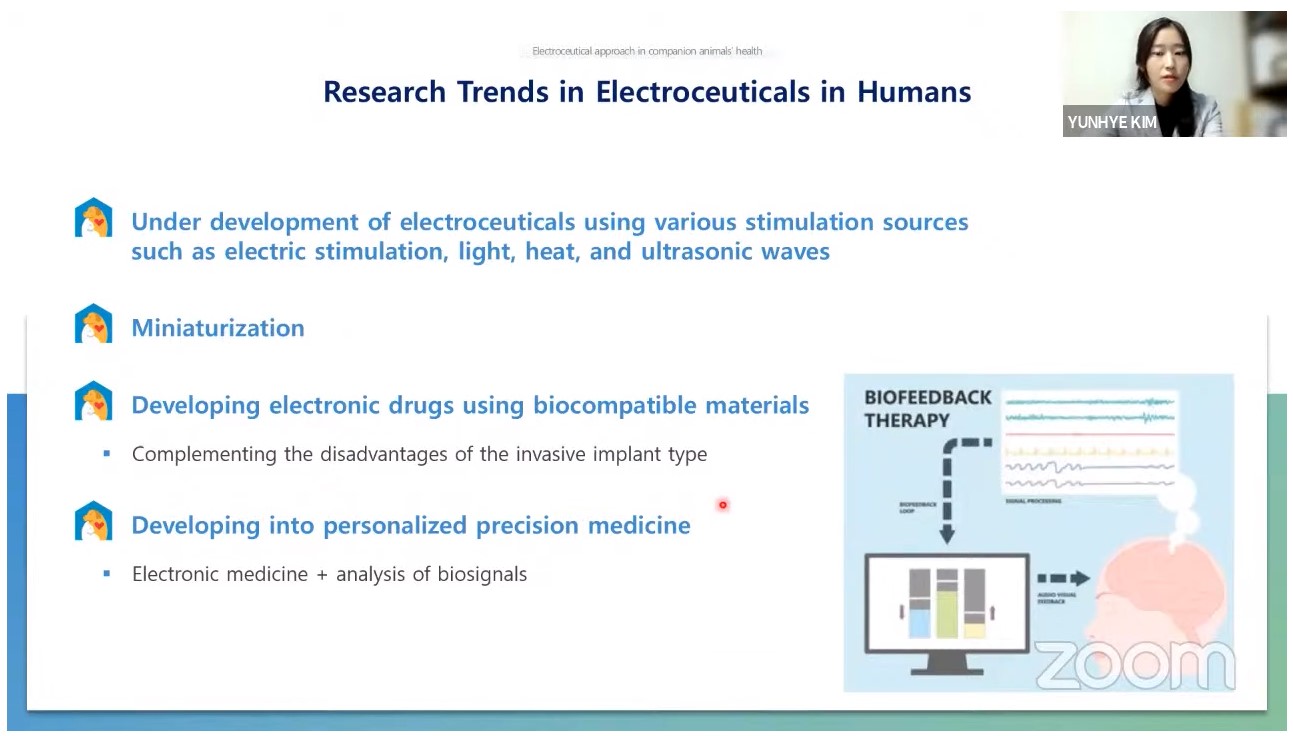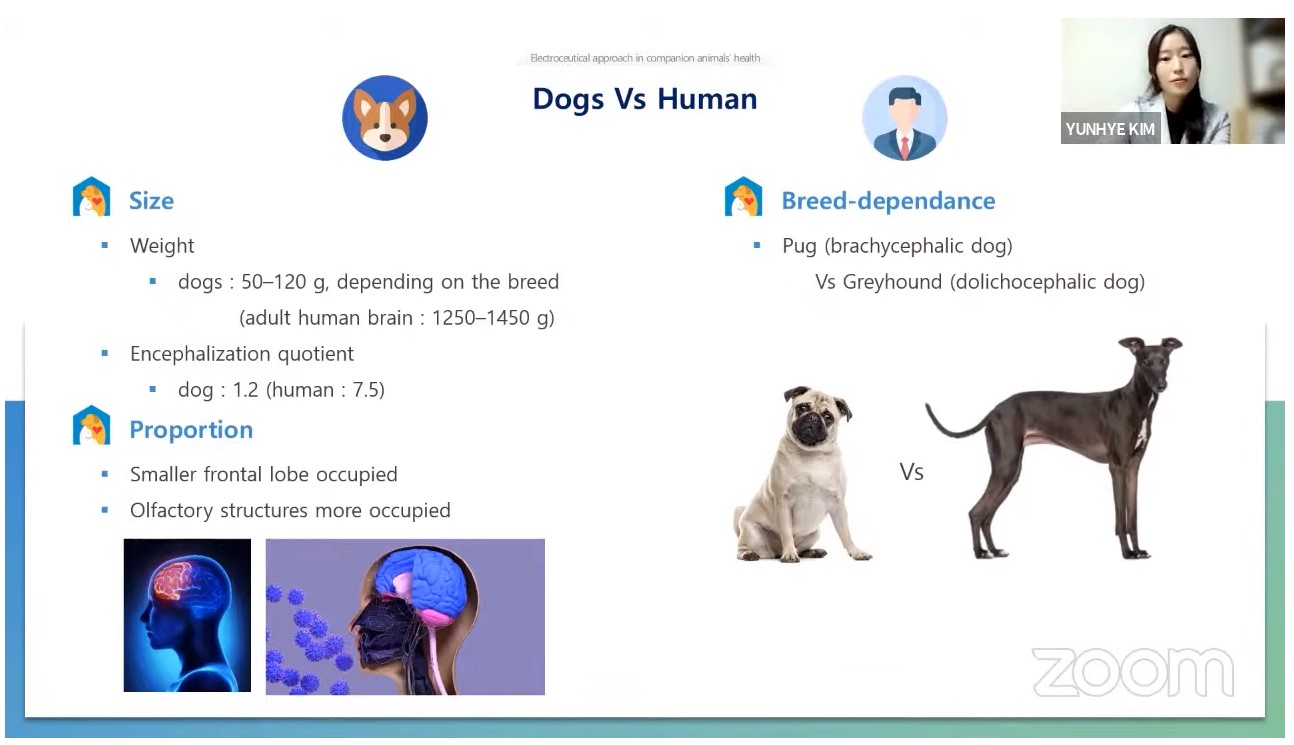ISSUES
Electroceutical Approach in Companion Animals' Health by Dr. Yunhye Kim
Content
(Companion Animal Digital Health Session 5)
Electroceutical Approach in Companion Animals' Health
Yunhye Kim, CEO, Vrain & Co
Dr. Yunhye Kim gave a talk about the topic of electroceutical approach in companion animals health. Dr. Kim has developed a company for the convenience of animals. She started her presentation with the introduction of Electroceuticals and the current stage in humans and animals. She also introduced her company which is a compound word of electronic and pharmaceutical, Electroceutical refers to an electronic device that produces a therapeutic effect by controlling nerve signals through electrical stimulation narrow medicine to be taken called a third-generation treatment. Electroceuticals conventional medicines are absorbed into the body and move around the body through the blood vessels to show their effects with a possibility of side effects on unexpected parts. Dr. Kim explained that in fact, there are a lot of few cases of side effects on the medicines. In addition, it is expected as alternative medicines to treat diseases that cannot be treated with existing medicines and it is the converged results of engineering technology, neuroscience, and data science. Dr. Kim mentioned that is expected that personalized treatment will be possible. Dr. Kim elaborated that there are many types of electroceuticals. There are invasive forms in which stimulation generators are injected into the body and non-invasive form in which they are attached to relative parts simulation sources which include electrical magnetic heat, optical, and ultrasonic stimulations. Dr. Kim emphasize that all organs of the body are controlled by regulating the activity of the nerves distributed electoral theory cause stimulates the corresponding nerve to control the action potential and it covers the damaged function of organ the global market for electricity current. As technology develops faster, the development of electroceutical is becoming more active. Dr. Kim summarized some of the key electroceutical examples in her presentation. There are devices that are implanted into the heart to treat bradycardia or tachycardic or recipients. There are Cochlear implants or retino implants to treat related diseases. There are devices implemented in the spine cord to control chronic pain and implant it deep in the brain or attached to the surface of the head to treat epilepsy, depression, dementia, and brain tumors by applying implantable or attached to electronic medicine to the vagus nerve and however, widely distributed in the body, it shows therapeutic effects on rheumatoid arthritis, migraines, obesity, and Parkinson's diseases. Recently, a device run on the wrist to improve the symptoms of Parkinson's disease and a device to contact to the neck to relieve symptoms of respiratory distress due to coronal disease have been approved by FDA. Although the electroceutical field is still in its infancy, its market and research are both rapidly expanding. Devices are being developed to be miniaturized in additional research on biocompatible materials which is actively being conducted to compensate for the disadvantages of the invasive implant type due to the development of data science. Electroceuticals are developing into personalized treatment by continuous feedback therefore, active research is being conducted in various disease models around the world.
Image Sources: Zoom Presentation Screenshot by Dr. Yunhye Kim
Dr. Kim continued to present on electroceuticals in companion animal cells. Dr. Kim confirmed that there are still no products that are officially approved for use in companion animals. Also, in the case of using electroceuticals in animals, it is for research on laboratory animals or a product modified from a human product is being used. The companion animal needed electroceutical whether it may be more of the respiratory needed for a convenient animal as in human. Dr. Kim claimed that it is probably the most advantages that it is safe as a targeted treatment since companion animals cannot take medicine by themselves. The owner who administers the medicine experiences a very stressful situation in which both owners and animals may develop medicine related trauma which makes it more difficult for owners to administer medication to their companion animals. The lifespan of companion animals increases as humans, the number of elderly animals is increasing as a result, aging diseases, chronic diseases and complex diseases are gradually increasing. Dr. Kim continuously explained that accordingly, the number of companion animals who need to take multiple medication is also increasing. Companion animals are being familiarized and humanized to the extent that a new world called “pet fam” has emerged in Korea and the demand for Companion Animal Health Care is becoming as strong as that of human. Therefore, the demands for alternative drugs that can compensate for the shortcomings and limitations on existing drug is also increasing the reason why Companion Animal only electroceuticals are needed. The companion animals and humans are not the same as dogs and cats are also different and each will need their own dedicated devices among various differences between humans and companion animals. When it comes to the differences in the brain and skin. The dogs and cats’ brain look same but the human brains differ from size. Relative proportions surface areas and numbers in dogs, the size of brain is smaller than that of humans. Dr. Kim then continued to explain the differences in skin. Dogs have more hair in their hair follicles than humans. They have a thinner epidermic layer and a higher surface temperature.
Image Sources: Zoom Presentation Screenshot by Dr. Yunhye Kim
Dr. Kim talked talk about her company which is just in which she established it in 2022 with the vision of a better quality of life for companion animals and their family. Dr. Kim entered into a research partnership with the Department of Veterinary Internal Medicine and Jeonbuk National University to develop and research electroceuticals. Dr. Kim’s company is conducting electroceutical development and research starting with the target disease model of cognitive dysfunction syndrome in companion animals and plans to gradually expand to various disease models. Through many years of Dr. Kim’s clinical experiences, she is at the forefront of filling the increase in age-related diseases due to the expansion of their lifespan. In particular, counseling on cognitive impairment of elderly companion animals and complaints of owners suffering from this disease are increasing. Demand for a treatment or cognitive impairment in companion animal is rapidly increasing but there is no appropriate treatment so far. Dr. Kim shared her own experiences having impairment problems from her own dog and due to this she believes and supports the underlying motivation for development. She explained that the source of our developing electroceutical is electric car stimulation specifically transcranial direct current stimulation.
At the present stage, Dr. Kim and her company has been conducting clinical trials to find the optimal combination of color muscle effective cone intensity range application sites and frequency obsession for a clinical application to companion animals. She then shared that in addition, they are developing a form of electoral suitable application to component animals and are preparing for ideal patent applications. Dr. Kim emphasized that there have been studies that show the effect of improving cognitive ability. When TDCS is applied to cognitive impairment patients, it was effective along and the effect increases synergistically when combined with training. Studies of TDCS on laboratory animals have been reported, however, there haven’t been any clinical research paper found yet that is applied to competent animals. TDCS will help improve cognitive impairment in convenient animals also these are pictures of the Prototype being applied to a dog the constant the consent of each dog was obtained from its owner before entering clinical trials we are testing the effects and side effects by applying an unknown to the left dorsal letter prefrontal cortex position and are Castle to the right dorsal retro prefrontal cortex position based on micro current stimulation. The search for a range that shows effects without side effects. Trying not only direct currents but also various types of current is also being considered. Dr. Kim shared her hopes and desires that one day companion animals needs to electroceuticals to treat their disease and their family will have no fear and no stress about administration of drugs.
Image Sources: Zoom Presentation Screenshot by Dr. Yunhye Kim


